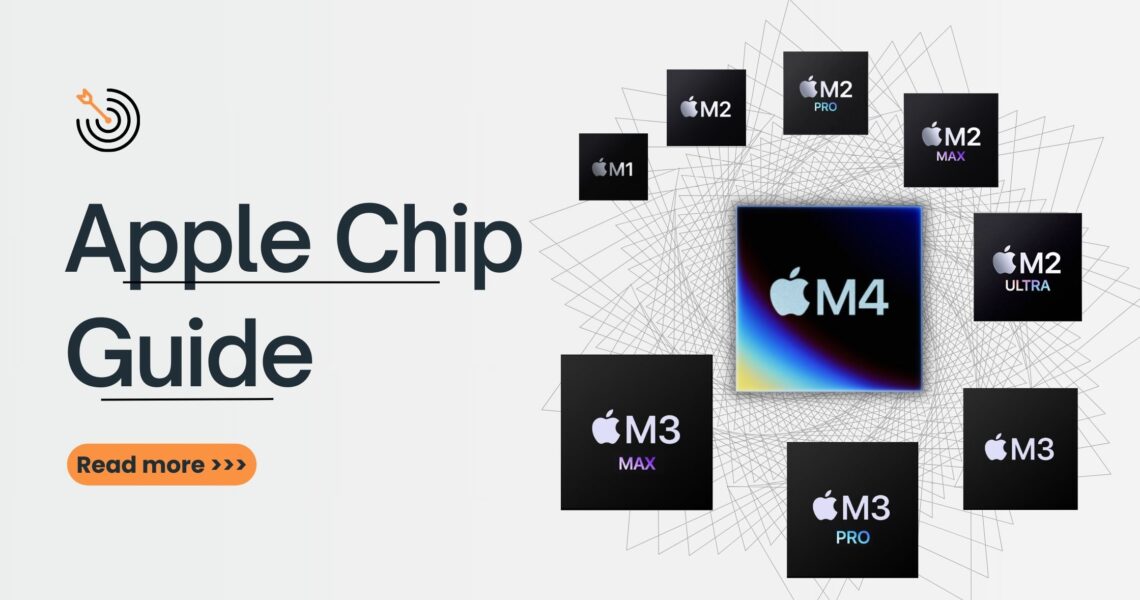Complete Guide to Understanding Apple Chips
When it comes to high-performance technology, Apple always stands out. Since the launch of its first “M” class chip, Apple has continued to innovate, releasing generations of processors that are increasingly powerful and efficient. The key to this extraordinary performance lies at the heart of all Apple products: their custom chips. In this comprehensive guide, we will take an in-depth tour of the different Apple M-class chips. Join us on this fascinating journey.
Which M-Class Chip Should You Choose?
M1 and M2 Chips
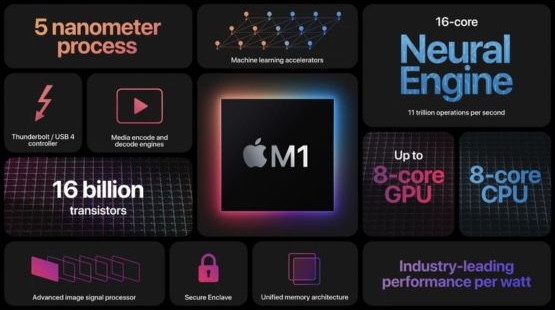
Apple’s first generation of chips, the M1, is excellent for everyday tasks and light creative applications like Photoshop or iMovie, making it the perfect choice for users looking for a balance of functionality and performance. The M2 chip, on the other hand, is a faster chip ideal for multitasking and mid-level applications, making it perfect for those who need extra power and insist on having all the editing capabilities at their disposal.
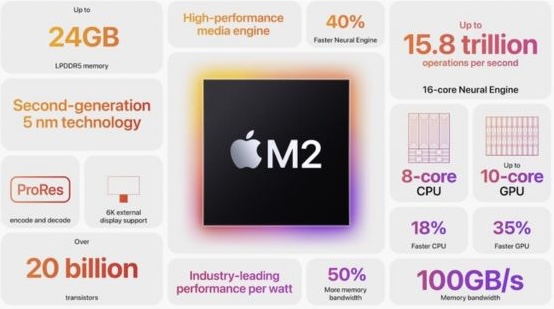
The Appeal of M2 Pro and M2 Max Chips
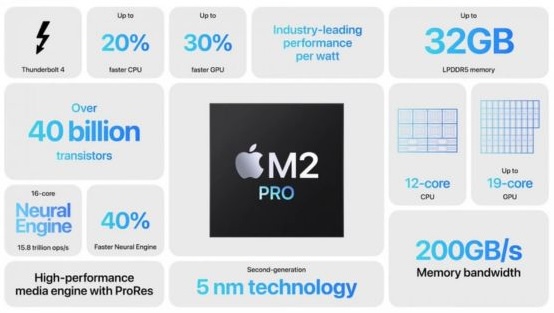
For professionals who require maximum performance in their tasks, the M2 Pro and M2 Max chips are ideal. These chips are extremely powerful, designed to handle applications like Final Cut Pro and Xcode effortlessly. They can handle the demands of 3D graphics and 8K video editing without a hitch, making heavy tasks feel like a walk in the park.
M3: Power and Flexibility
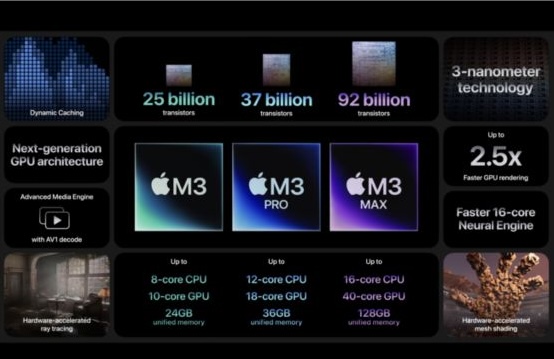
The M3, M3 Pro, and M3 Max chips offer exceptional performance in devices like the Mac and iPad Pro. These chips feature significant improvements in energy efficiency and power, ideal for demanding creative tasks such as 4K and 8K video editing in Final Cut Pro, 3D rendering in Blender, or development in Xcode.
M4: The Latest Generation of Apple Chips
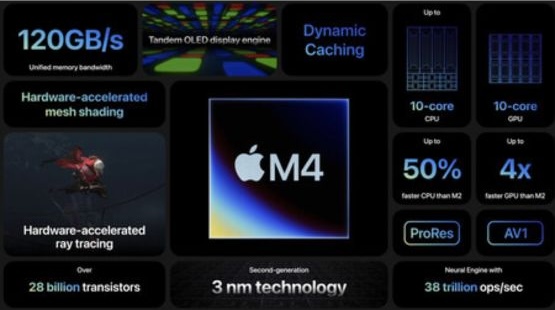
Apple’s M4 chip represents a significant advancement in the performance of the iPad Pro, thanks to its second-generation 3-nanometer technology. This chip incorporates innovations like hardware-accelerated ray tracing and mesh shading. The M4 Chip is optimized for AI-intensive tasks, such as 4K video editing in Final Cut Pro and advanced graphics processing in games.
Features of Apple Chips
Each of Apple’s chips contains unique technology that makes them some of the most powerful and energy-efficient chips on the global market. Below, we compare the features of Apple chips.
Apple Chips Comparison Table:
| Chip | CPU Cores | GPU Cores | Unified Memory (RAM) | Overall Performance | Typical Uses |
|---|---|---|---|---|---|
| M1 | 8 | 7 or 8 | 8GB to 16GB | Excellent for daily tasks, light creative applications | MacBook Air, Mac mini (2020) |
| M2 | 8 or 10 | 8 or 10 | 8GB to 24GB | Faster than M1, ideal for multitasking and mid-level creative applications | MacBook Air (2022), MacBook Pro 13-inch |
| M2 Pro | 10 or 12 | 16 or 19 | 16GB to 32GB | Very powerful, ideal for professionals needing high performance in apps like Final Cut Pro and Xcode | MacBook Pro 14 and 16 inches, Mac mini |
| M2 Max | 12 | 30 or 38 | 32GB to 96GB | The most powerful chip, ideal for professionals working on large projects like 3D graphics and 8K video editing | MacBook Pro 14 and 16 inches, Mac Studio |
| M2 Ultra | 16 or 24 | 60 or 76 | 64GB to 192GB | The most powerful chip from Apple, designed for professionals needing maximum performance, like ML scientists and engineers | Mac Studio |
| M3 | 8 or 10 | 8 or 10 | 8GB to 24GB | Latest generation, offers significantly improved performance over M2, ideal for daily tasks and mid-level creative applications | iMac, MacBook Pro 14 inches, MacBook Air (2023) |
| M3 Pro | 11 or 12 | 14 or 18 | 18GB to 36GB | Offers significantly improved performance over M2 Pro, ideal for professionals needing high performance in apps like Final Cut Pro and Xcode | MacBook Pro 14 and 16 inches (2023) |
| M3 Max | 14 or 16 | 30 or 40 | 36GB to 96GB | Offers significantly improved performance over M2 Max, ideal for professionals working on large projects like 3D graphics and 8K video editing | MacBook Pro 14 and 16 inches (2023) |
| M4 | 9 or 10 | 10 | 8GB to 16GB | Enables subject isolation in 4K video in Final Cut Pro, and can automatically create a score in real time with StaffPad | iPad Pro 11″ and 13″ (2024) |
Simplifying Your Options
The choice of the right chip for you entirely depends on your needs. If you seek balanced performance for everyday tasks, the M1 or M2 may suffice. For those who need more processing and graphics power, the M2 Pro and M2 Max chips are ideal. Finally, if you crave the latest in technology and performance, the M3 and M4 chips are the way to go. Be sure to consider these options in your next purchase at shopdutyfree, your trusted Apple store.
For more information and useful tips on Apple products and the latest tech news, don’t hesitate to visit our blog. Here you’ll find everything you need to make an informed choice and buy the Apple product that suits your needs.
Frequently Asked Questions
What is an M2 Pro chip?
An M2 Pro chip is an Apple processor that offers very powerful performance, ideal for professionals needing high performance in applications like Final Cut Pro and Xcode.
Where can I buy Apple products with M2 or M3 chips?
You can buy Apple products with the latest generation chips at the online store shopdutyfree, which offers a wide variety of Apple devices at competitive prices.
What is the difference between the M2 and M3 chips?
The M3 chips offer significantly improved performance compared to the M2 chips. They are also better in terms of energy efficiency, offering a superior computing experience.
Are the M2 Max and M3 Max chips the most powerful from Apple?
The M3 Max chip offers superior performance compared to the M2 Max, due to its capacity to handle larger projects like 3D graphics and 8K video editing.
Is the M1 chip still a good choice?
The M1 chip remains an excellent option for everyday tasks and some creative applications, especially if you’re looking for a budget-friendly option.

